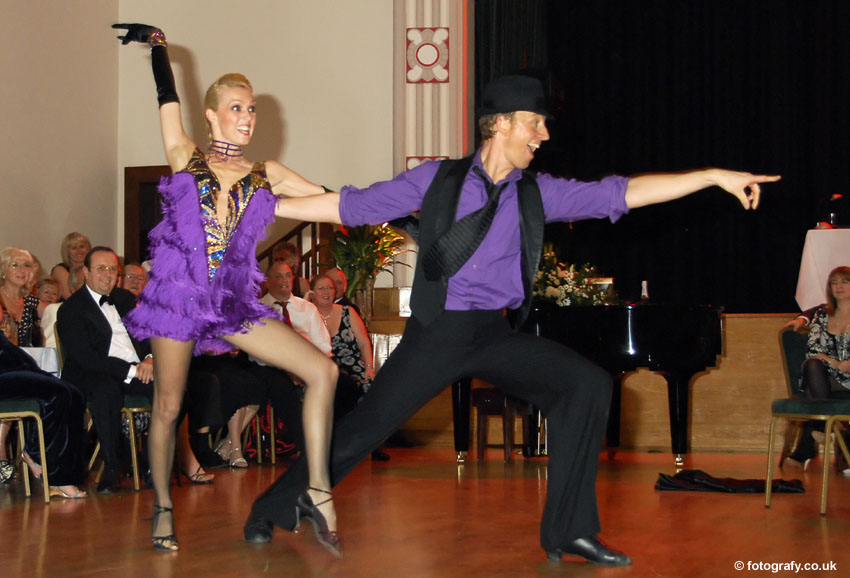
"Above, Ian Waite and Camilla Dallerup dancing the Ballroom Jive. Their DVD, The Magic of Dance includes a great example of the style."
In Part One we looked at how Jive evolved from its beginnings in Harlem in the 1920s to a wide range of different styles across the world. There are two other strands that are worth picking out, which have diverged significantly and have enormous followings around the world today: Ballroom Jive and Modern Jive.
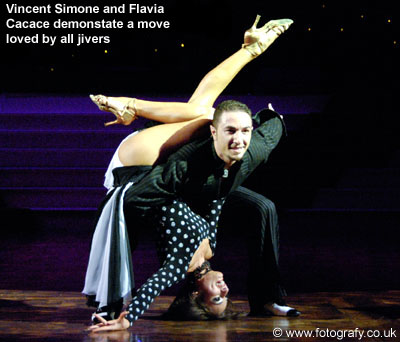
Back in the 1930s, the American Society of Teachers of Dancing (ASTD) and the Dance Teachers Business Association (DTBA) weren't so sure about this new dance, calling it a fad that would not last out the winter. Some groups even tried to ban it from dance halls using rationalisations such as the fact that, because Jive was non-progressive, it disturbed the other dancers who were progressing anti-clockwise around the dance floor. However, as its popularity grew, they realised that they could no longer ignore it and the ASTD decided to start teaching their own variant of it that they called The East Coast Swing, making it an official dance in 1942.
The Arthur Murray studios looked at what was being done on the dance floors in each city and directed their teachers to teach what was being danced in their respective cities, but eventually it became formalised, thus enabling common teaching syllabuses and effective judging criteria for competitions.
In 1960 a new category of competition dances was put together called "Latin & American", combining four Latin dances with one American - the "Ballroom Jive". The usual abbreviation to "Latin American" should not be assumed to imply that Jive originated in Latin America!
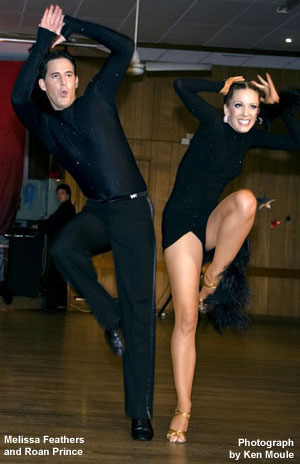
A key player at this stage was Walter "Wally" Laird, three times World Ballroom Champion. Walter, a scientist from Essex, had a very analytical mind and was fascinated by the physiology of movement in dance. From his early beginnings, dancing as a schoolboy with his sister Joan, and, in 1936, winning an early Jitterbug championship, he went on to spend years studying the Jitterbug along with Cuban and Brazilian dance forms. The result of his studies was the codification of the Latin & American dances in his groundbreaking Technique Of Latin Dancing in the early 1960s - still the bible for ballroom dancers all over the world.
It is said that one of Walter's intentions was to make Lindy more beautiful or elegant. Opinion is divided on whether he succeeded or not!
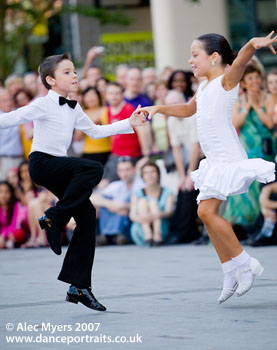
This competitive ballroom version of Jive is based on a six-beat pattern of two fast syncopated chassés (side, close, side) followed by a slower break back and replace forward; it prohibits any kind of air step and is usually danced in an enhanced bouncy style, very upright and with lots of kicks. In competition it is danced at a fixed speed of 176 beats per minute (bpm), and will be most familiar to non-dancers as the type of Jive they see on Strictly Come Dancing or Dancing With The Stars!
The Ballroom Jive is a very fast, energy-consuming dance. In competition, after having performed the Samba, Rumba, Paso Doble and Cha Cha, the dancers have their stamina tested by performing The Jive.
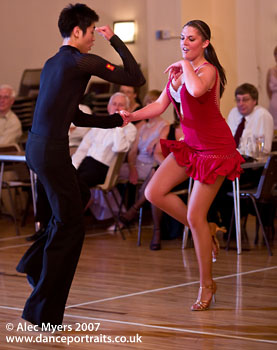
"In competition, this very fast, energy-consuming Ballroom Jive is danced last to test the competitors' stamina."
These days Ballroom Jive is controlled by organisations such as the ISTD, IDTA and UKA, each of which has its own syllabus for the Jive, though the differences are minimal, for example minor variations in the description of exactly how far one should turn on a particular step, or exactly where the feet should be placed. This gives a framework for teaching the standard 27 moves that make up the Bronze, Silver and Gold medals, recognised world wide.
Ballroom Jive is not normally taught alone, but as part of the whole Latin American syllabus. Dance studios need to adapt what they teach to be able to provide a style that they believe the general public can cope with, so they also teach simpler variations, for example dropping the chassé or adding four-beat Rock'n'Roll figures, depending on the type of class they are teaching. In the US they may offer their own version of The East Coast Swing as well. At ballroom social dances the music for the Jive will often be slower than the 176 bpm used for competitions.
"Modern Jive, a separate branch of the ever-spreading Jive tree, is a style that is growing at a phenomenal speed."
So far we have looked at the traditional Lindy/Jitterbug/Rock 'n' Roll styles and the Ballroom Jive. But for a large part of the population these are not necessarily what they are looking for.
Aficionados of the traditional styles are often also interested in the fashions, styles and music of the era; they dance to Swing or Rock 'n' Roll music and at their major functions they may dress up in period clothes.
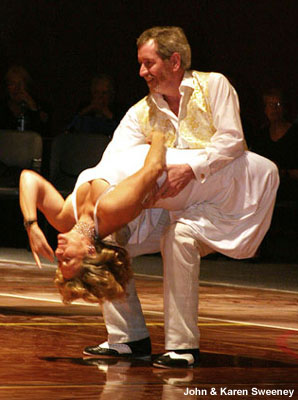
For Ballroom Jive, it is not easy to find somewhere to learn it without having to learn all the Latin dances as well, and the primary opportunities for dancing Ballroom Jive are at ballroom dancing social functions or competitions.
If neither of these approaches interests you, or you are not sure you will ever get your feet to do what they are supposed to, then where do you go to learn a Jive-based partner dance? Fortunately, there is an answer: Modern Jive, a separate branch of the ever-spreading Jive tree, and a style that is growing at a phenomenal speed.
Back in the 1960s the Twist (designed to be easy to do on sand for lovers of beach music!), and similar new solo dances, propagated instantaneously around the world by the new medium of television, tolled the death knell for the partner dancing that had been such a key part of social life until then. The dance studios and traditional clubs kept their styles alive, but at a much reduced level.
Now the French had taken what they had learnt from the American GIs in the 1940s and developed their own versions of it. In the late 1970s some key players, such as Michel Ange Lau, James Cronin and Christine Keeble, had learnt this style of dance and wanted to dance it in the UK. In 1978 Michel started teaching Le Bop, a French style of Jive, at the Centre Charles Peguy, a French Youth Centre in London's Leicester Square.
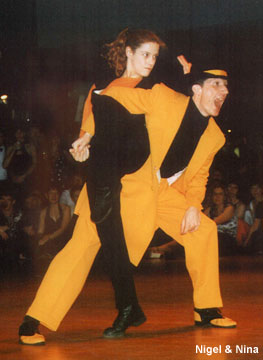
Frustrated by the inability to dance Le Bop to the increasing amount of disco music that the DJs were playing, Michel Ange Lau started to develop a variant that could work with any music, dropping the fixed number of beats in a move. Michel called his new style Le Roc, a name that was never copyrighted in the UK and is still used by many clubs today. James Cronin chose the name Ceroc and eventually set it up as a branded business ("Ceroc" is a registered trademark). During the 1980s the dance was confined to London, and a few other places like Bristol where Michel Gay, who had learnt in London, set up his own Le Roc club. With the 1990s it started to spread, with Ceroc opening franchises in Oxford, Norwich and, eventually, many other cities. Migrant teachers also established Modern Jive in Australia and New Zealand, each of which now has dozens of clubs.
"Many people who had learnt modern jive decided they would like to teach it, so they set up their own clubs."
The number of clubs grew rapidly. Many people that had learnt the dance decided they would like to teach it, so they set up their own clubs. The Le Roc Federation was set up by a group of independent teachers to help other independent teachers, and affiliated itself with the UKA. Some ex-Ceroc franchisees also decided to set up their own businesses with new names like leJive, mo'jive and Blitz. With the diversification of brand names, there was a need for a generic name for this style of dance and it became generally known as "Modern Jive". This expansion continued into the 21st century; now there are over 400 weekly classes in the UK, with over 200 organisations arranging classes, weekend dances (known in the UK as freestyles), workshops, competitions and dance weekends or holidays. Ceroc is still by far the largest, with over 175 of the weekly classes, and, with larger class sizes on average than many of the independents, probably well over 60% of the market place. Ceroc and other organisations are starting to spread through the US and many other countries.
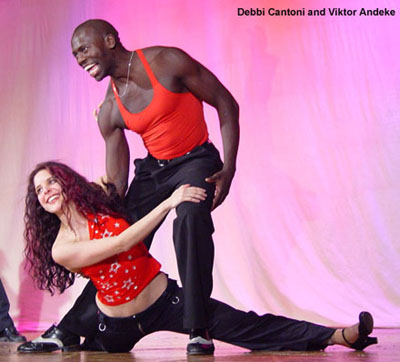
From a dance point of view, Modern Jive has developed into an arm-led partner dance, with no specific foot-work (you just move your feet to the beat), with hundreds of moves, danced to a very wide variety of music, essentially any hit from the last hundred years that is in 2/4 or 4/4 and is between 110 and 170 bpm.
Michel Lau did indeed define some footwork back in the 1980s, and the Le Roc Federation does have a footwork syllabus, but very few clubs ever teach anything more sophisticated than step forward/step backward, though some will tell you which foot they would recommend you use at certain parts of certain moves. If you go to a workshop you may be taught the best footwork for spinning, or how to do footwork-based moves that have been incorporated into Modern Jive.
"The format of a typical Modern Jive evening has contributed significantly; it is a very social event."
The removal of the requirement to learn some footwork before you can get on the dance floor is a key part of the success of the dance. But by itself it is not enough. The format of a typical Modern Jive evening has contributed significantly; it is a very social event. An evening normally runs from around 8pm to around 11pm, starting with a 45-minute beginner class that teaches four moves linked together, followed by a short freestyle break, then a 30-minute intermediate class. Once that is over the lights go down, the music goes up and the rest of the evening is basically a night-club.
Each organisation decides on its own set of beginner moves (and their names!), but there is significant overlap so you can go to any club and learn a few more moves. Ladies with any sense of balance and rhythm can be led into dozens of moves on their first night by a good leader. The men of course have to learn all the moves and how to lead them, but the format is designed so that even a beginner can get out on the floor after his first lesson and lead the four moves he has just learned over and over again. Many clubs help beginners by providing Taxi Dancers or Coaches who's job is it to dance with the beginners.
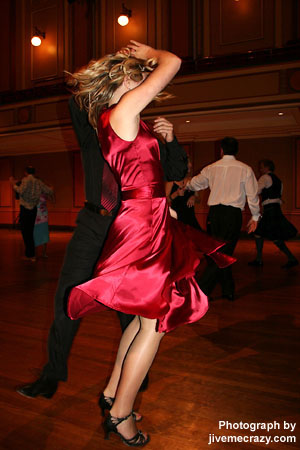
The classes are run in long rows, men facing ladies, with spare ladies (or men) waiting in a queue. The ladies (or men) are moved around every minute or so, so that everyone gets a chance to practice the moves with lots of different partners. The culture in the freestyle sessions is very much one where everyone dances with everyone. In many ways, for beginners, basic Modern Jive is more about learning to socialise on the dance floor than about actual dancing!
In most dance styles the two partners move in the same direction, with one partner stepping into the space recently vacated by the other dancer. In contrast, Modern Jive begins with the dancers stepping away from each other and then back to the neutral position. Collisions are extremely rare and beginners do not have to deal with the embarrassment of having stepped on their partner’s toes.
"Over the years, skilled teachers have taken advantage of the simple structure to add styling and moves from many other dances."
The accessibility of Modern Jive for beginners, the night-club environment and the use of chart music (from whichever decades the particular DJ favours) are the reason why hundreds of clubs get up to two hundred people dancing on a weekday evening.
Many dancers reach a plateau; they master a dozen moves (out of the hundreds that get taught at a typical club) and use them happily once or twice a week for the rest of their lives. But for those who want to learn more, Modern Jive is a very rich seam to mine. Over the years, skilled teachers have taken advantage of the simple structure to add styling and moves from many other dances, thus evolving a very rich and varied form of dance with many hundreds of moves. They have added styling and moves from Lindy Hop, Salsa, Ballet, Latin, Ballroom, Hip-Hop and countless other sources. Add in a wide range of drops, seducers, leans, lifts and air steps and you get a very varied dance. And if that is not enough you can try Double Trouble (Triples) - leading two ladies at once! The range and quality of dancing at the Modern Jive competitions is quite amazing - and all from amateurs.
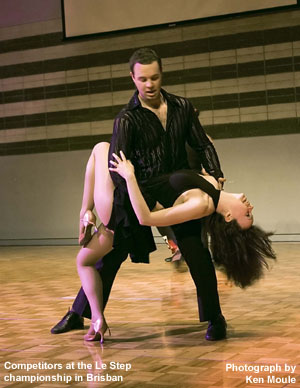
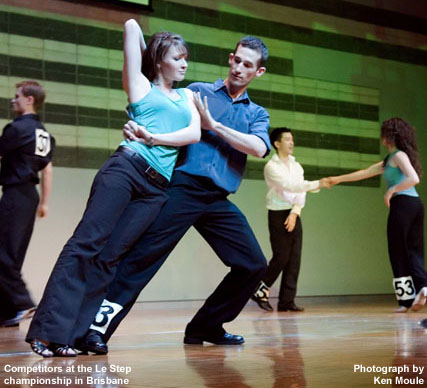
Of course there is significant overlap between all the styles of Jive. If the music speeds up above 160 bpm at a Modern Jive dance then you will see the better dancers throwing in Lindy and Rock 'n' Roll to cope with it and as it drops below 120 they will move into Blues or West Coast Swing. If they know Ballroom Jive routines they will throw those in - though perhaps not with full Ballroom Jive styling.
Many dancers don't realise that they are doing a modern form of jive, they just know it by the name of the club they go to, or what that organisation chooses to call it - apart from "Modern Jive" names include LeRoc, leJive, Mo'jive, French Jive (which it isn't!), Salsa-Jive, Smooth Jive, Cool Jive, Le Bop, Le Step, Night-club Jive and lots more being made up all the time.
No doubt, as the music changes in the future, the Jive will shift again to embrace it, while those who love the existing styles will continue to dance them as they have done since the beginning of the last century. Whatever happens I think we can guarantee that Jive will still be with us.
See you on the dance-floor!
Thanks to all these sites that helped me research this article
Visit modernjive.com to find out more about Modern Jive classes, major weekend events, competitions and DVDs, together with links to hundreds of useful sites.
The The Modern Jive Toolkit video explains all the techniques of Modern Jive.
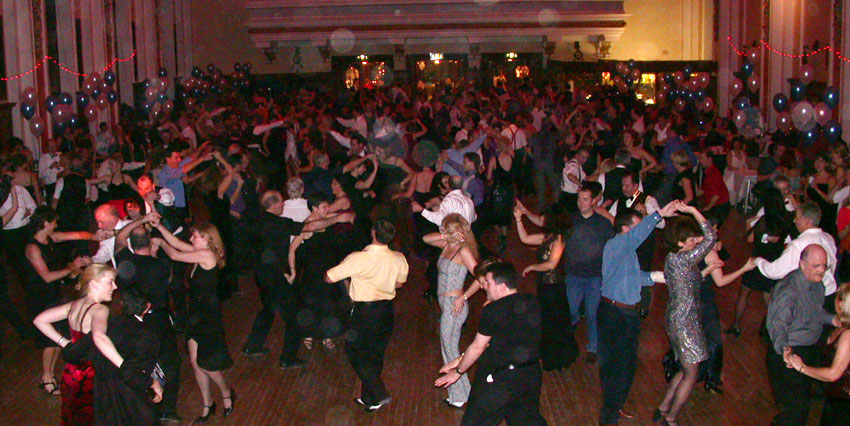
The original version of this article appeared in the September and October 2007 issues of Dance Today, the magazine for social and competitive dancers.
This article and the accompanying images are copyright John Sweeney and the acknowledged sources. All rights reserved. No part of this article or these images may be reprinted, stored in a retrieval system, or transmitted in any form or by any means, electronic, mechanical, photocopying, recording or otherwise, without the prior written permission of John Sweeney.